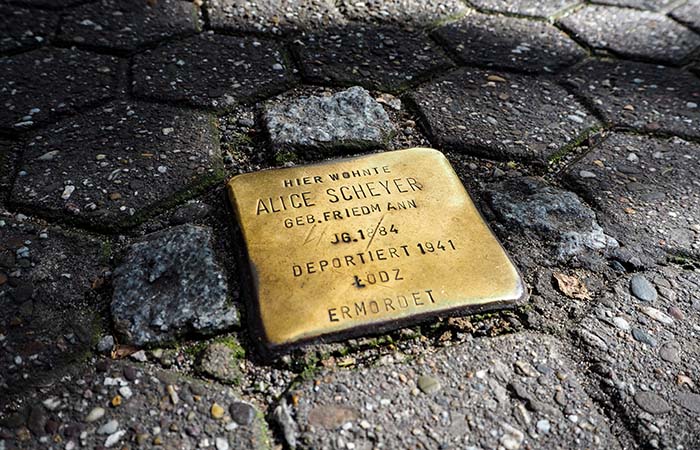Female Rage in Art
Since Auguste Toulmouche’s 1866 masterpiece The Reluctant Bride recently captured the internet’s attention, discussions about female rage...
Martha Teverson 6 May 2024
“There must be a Jew buried here” – this was a phrase commonly uttered by some Germans before World War II, when they stumbled over a stone in the German capital. It speaks volumes about the Anti-Semitism of the time. Nowadays, it can happen that we stumble again on the soil of Berlin, but fortunately we do not swear as before.

If we look to see what we touched with our foot, we might discover a small, brass paving stone with an inscription. Its face protrudes slightly from the ground in which it is embedded, just enough to trip us up – hence its name, Stolpersteine, meaning “the stone that trips”. All these small, square paving stones measuring 10 centimeters across, constitute the memorial work of Berlin artist Gunter Demnig, installed in 1994.
On the face of each paving stone is inscribed “Hier wohnte” (“Here lived”) followed by the name, date of birth, date of arrest, and date of death in a deportation or extermination camp of the person concerned.

There are no less than 48,000 cobblestones of this kind, scattered all over Europe. Each paving stone, handmade by the artist, is unique and remains an artisanal creation. Indeed, for the artist, making each work himself is a way of “spending time” with the person whose name is inscribed on the piece. It’s also a way of not participating in capitalism, which he deems partly responsible for these mass killings.
Embedded in front of the victim’s last home, the pavement bears witness to their existence and allows them not to be forgotten. In order to read the various inscriptions we have to bend down, to bow down, rendering by this action a kind of personal homage to the disappeared being.

This astonishing work is a way of countering Nazi ideals. Indeed, the latter wanted to completely obliterate the Jews, to make them disappear “body and soul”. However, these cobblestones, by the permanent affirmation of the existence of the victims whose identity is restored to them, are a victory against Nazi ideology. Note that these “stumbling stones” concern not only Jews, but all victims of Nazi barbarism. Here lived a gypsy, a political opponent, a homosexual, a Jehovah’s witness, or even a handicapped person.

Every time we stumble upon a work by Gunter Demnig, we remind ourselves that in this very place we are in, a man, a woman, a child has left part of their story.
DailyArt Magazine needs your support. Every contribution, however big or small, is very valuable for our future. Thanks to it, we will be able to sustain and grow the Magazine. Thank you for your help!